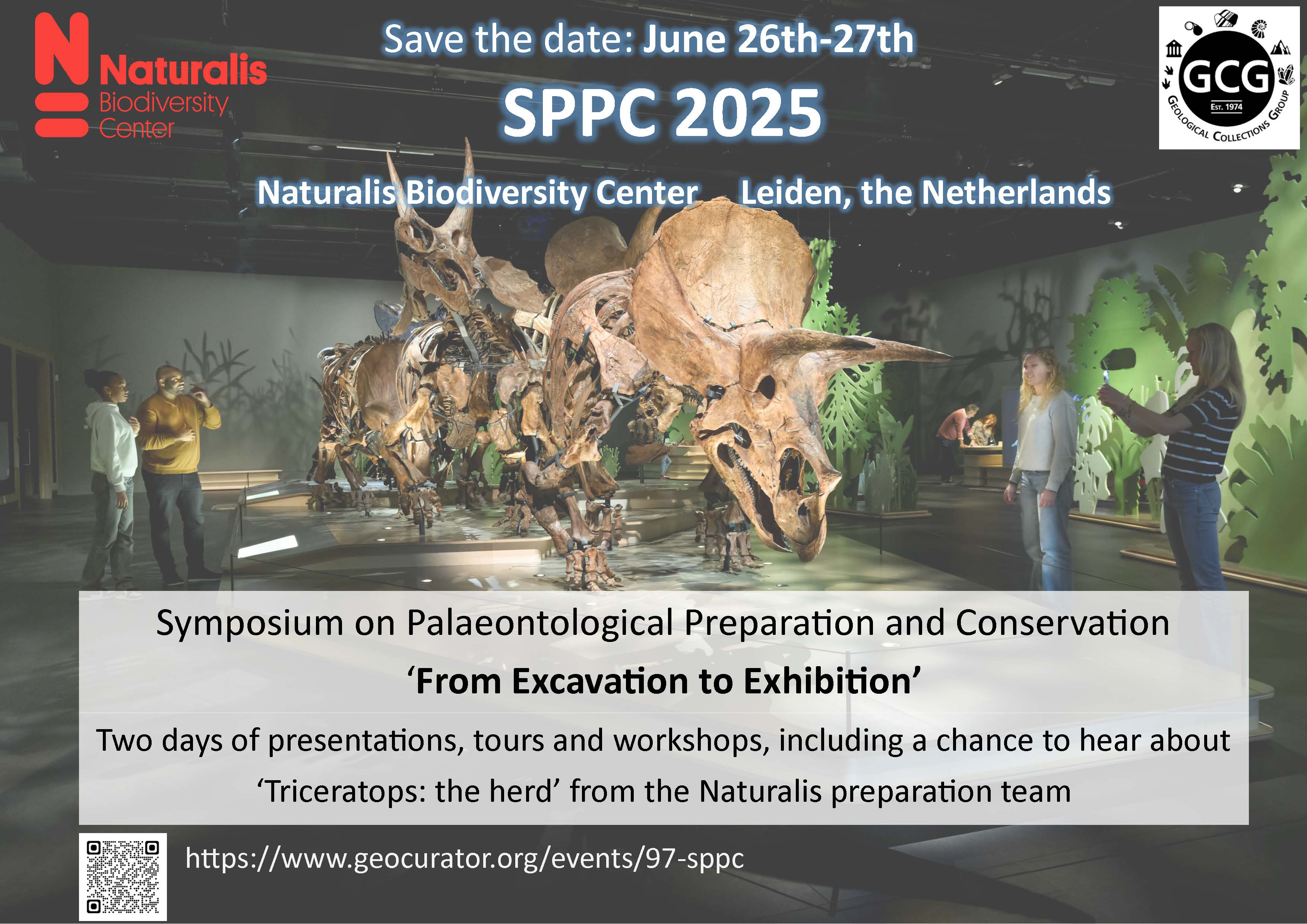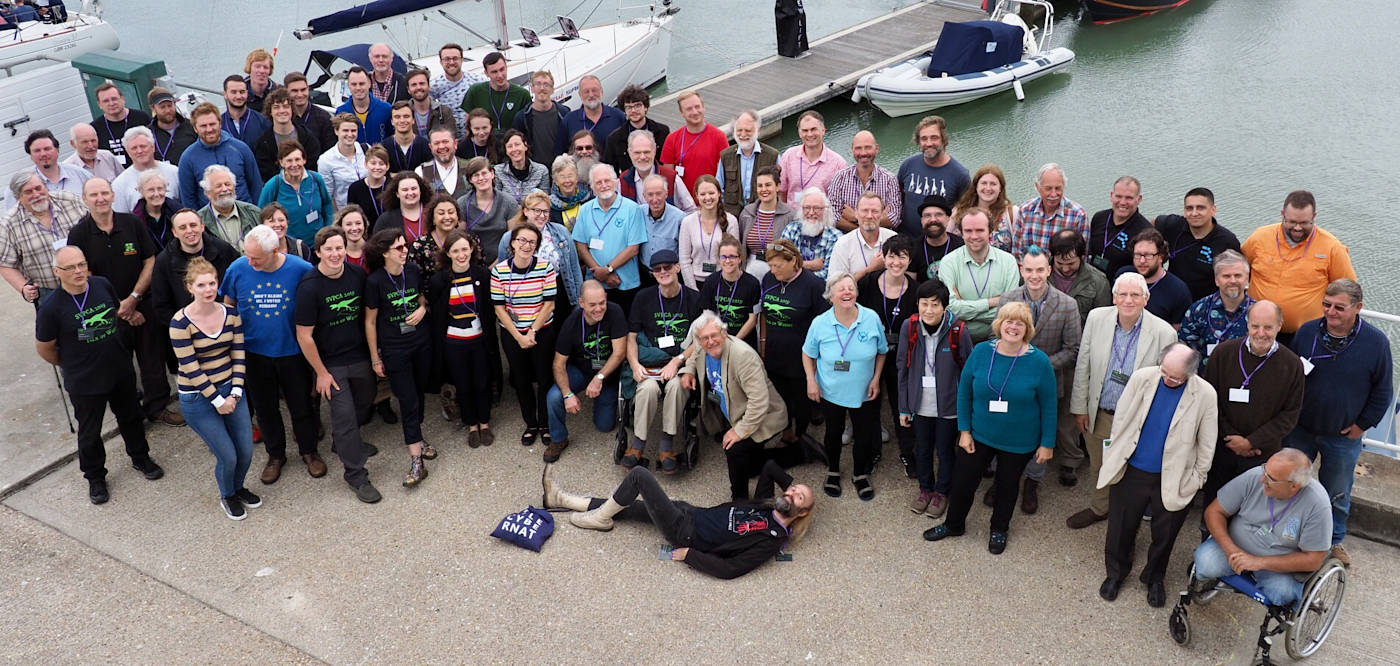SPPC 2025 - Leiden
The 30th Symposium of Palaeontological Preparation and Conservation
Naturalis Biodiversity Center, Leiden, 26-27th June 2025
From Excavation to Exhibition
Call for abstracts
Please send abstracts of up to 250 words plus an image to
Examples of previous years’ abstracts can be found online at https://www.geocurator.org/events/97-sppc

The 30th Symposium on Palaeontological Preparation and Conservation will be held in the Netherlands this year on 26-27th June.
The theme will be From Excavation to Exhibition and we hope to broaden our usual remit to include more aspects of the story of how geological collections end up on display in our museums, as well as their conservation and preparation.
Two days of presentations, tours and workshops, including a chance to hear about developing “Triceratops: the herd” exhibition from the Naturalis preparation team.
Day 1: Registration, presentations and posters (lunch included)
Day 2: Workshops and tours (lunch included)
Workshops
You may attend multiple workshops on the second day of the symposium, but please indicate your first preference so we can get an idea of numbers.
- Radioactive bones, and how to deal with them
- How to start up a project for pyrite in a natural history collection
- How to build frames for exhibitions
Suggested hotels nearby
- Fletcher Hotel
- Ibis Hotel
- IntercityHotel Leiden
- Golden Tulip & Tulip Inn Leiden Centre
If you would also like to meet up in the evening we suggest Stadscafe van der Werff
There is another event in Leiden at this time, so please do book your hotel as soon as possible.
This event is aimed at Fossil preparators, conservators, mount-makers, exhibition specialists, archaeologists, volunteers, students, curators
This is the ticket for non-GCG memners This is the ticket for GCG members and those who are unwaged You may attend multiple workshops on the second day of the symposium. Please rank your choices in terms of preference (e.g. 1 = 1st choice, 2 = 2nd choice, 3 = 3rd choice). In the member information below please just fill the mandatory boxes with your information. You may attend multiple workshops on the second day of the symposium. Please rank your choices in terms of preference (e.g. 1 = 1st choice, 2 = 2nd choice, 3 = 3rd choice). In the member information below please just fill the mandatory boxes with your information. You may attend multiple workshops on the second day of the symposium. Please rank your choices in terms of preference (e.g. 1 = 1st choice, 2 = 2nd choice, 3 = 3rd choice). In the member information below please just fill the mandatory boxes with your information.Individual Registration
Ticket Information
Ticket Type
Price
Quantity
Non-member
EUR80.00
Member and unwaged
EUR75.00
Workshop 1: Radioactive bones, and how to deal with them
EUR0.00
Workshop 2: How to start up a project for pyrite in a natural history collection
EUR0.00
Workshop 3: How to build frames for exhibitions
EUR0.00
What is SPPC?
The SPPC is intended as a forum in which professionals, amateurs and researchers alike, interested in all aspects of preparation, conservation, model-making and related subjects, can participate. The SPPC offers a unique opportunity to meet friends and colleagues and to discuss recent developments, ongoing research, and other, often museum related, projects. Although the SPPC generally precedes the the SVPCA conference, contributions are not limited to the field of vertebrate palaeontology.
SPPC Conferences have been run since 1992, either before or after the SVPCA, and many participants attend both conferences. Over recent years the number of talks on offer has been in decline, and there is a need for discussion on the nature and identity of this event. Conferences are held in a variety of venues, and offer a great opportunity both to share experience and to have the chance to look over the facilities other organisations and how they are used.
SPPC abstract archive
This section contains a listing of talks and posters delivered at SPPC in previous years. If you are wondering what SPPC is all about, or if it is for you, then this is a good place to start. The abstracts are organised by year - if you are looking for a specific abstract, then please try using the search function in the right hand menu of the website.
We particularly encourage you to check out the following links:
- A full listing of abstracts previously presented, from 1992 to the present
- Posters and video from our 2020 virtual event
- Posters from our virtual event held in 2021
- Posters and talk abstracts from 2022
- Posters and talk abstracts from 2023
- Posters and talk abstracts from 2024

